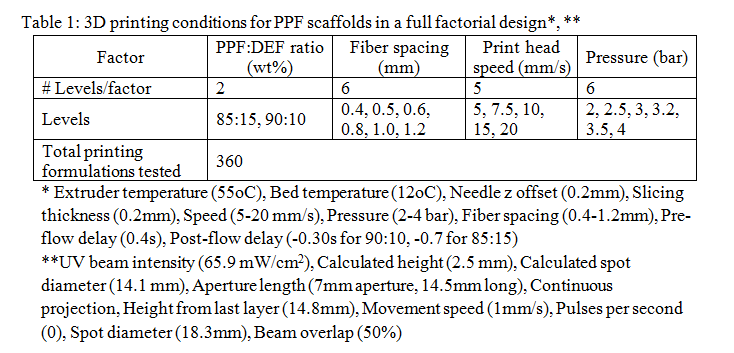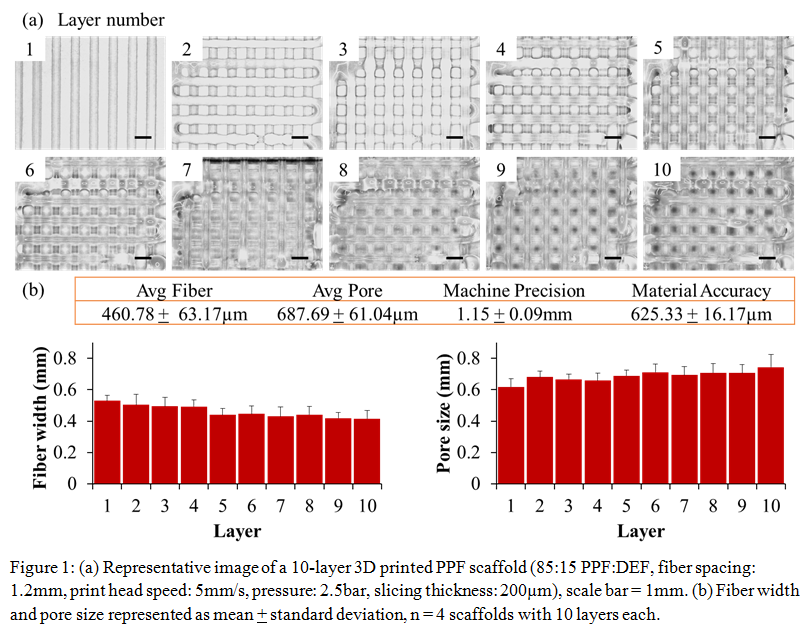Introduction: Poly(propylene fumarate) (PPF) is a photocrosslinkable polyester that has been widely used for tissue engineering applications, and has more recently been utilized with rapid prototyping (RP) systems that use photocuring as their primary means of printing. However, while PPF is advantageous as it is a flowable polymer, the viscosity and extrudability of the printing material can be more finely tuned with temperature, pressure, and printing speed regulation using an extrusion-based fused-deposition modeling (FDM) approach. Several formulations of PPF have been evaluated for their printing resolution – including fiber diameter, fiber connectivity, and pore size – in a factorial study design. Printing PPF with a FDM-based system provides flexibility in incorporation of bioactive molecules and drugs, which is not easily achieved with stereolithography techniques, and the use of this system offers improved control over printing the polymer as part of a complex tissue-engineered construct.
Materials and Methods: PPF was synthesized in the laboratory and number average molecular weight (Mn 2378) and polydispersity (PDI 1.87) were determined with gel permeation chromatography (relative to polystyrene standards) following previously established methods[1]. Diethyl fumarate (DEF, Sigma Aldrich), the monomer from which PPF was synthesized, was used to reduce the viscosity of the printing solution in two ratios (PPF:DEF 85:15 and 90:10 wt/wt), and 1wt% Irgacure 819 (BAPO, BASF) was added to the printing solution as a photocrosslinking agent based on previous methods[2]. 3D printing models were designed (SolidWorks, Waltham, MA) and sliced (Bioplotter RP, EnvisionTEC), and printing solutions were heated for 30 min prior to printing. Square scaffolds (10x10mm) were printed (3D Bioplotter, EnvisionTEC) following a full-factorial design (see Table 1), which includes printing parameters used and settings for UV crosslinking. Briefly, fibers of PPF:DEF:BAPO were deposited layer-by-layer and each layer was crosslinked with UV light, and images were acquired for every layer. Printed scaffolds were then post-processed in an EnvisionTEC flash box for 2000 flashes. Images were used to quantify pore size and fiber diameter (ImageJ, NIH).

Results and Discussion: Figure 1 shows a representative scaffold and analysis of pore size and fiber diameter. Imaging of sequential layers allowed quantification of both the material precision and the printing system accuracy, which can be directly compared to that of other materials and FDM systems. Overall, layer precision was high using the FDM system with only a 7.8% error among layers. The PPF fibers had larger fiber widths than slicing thickness, which may be due to fiber pooling during printing.

Conclusions: While printing techniques have been investigated for PPF, few have investigated the fiber extrusion of this polymer. Using a FDM-based system, it is possible to print high viscosity PPF solutions with precise control over fiber diameter and pore size. Furthermore, FDM allows inclusion of bioactive molecules and is more amenable to fabrication of larger scaffolds that would be beneficial in critical-sized defect models for bone and cartilage tissue engineering.
References:
[1] Kasper FK, et al. Synthesis of poly(propylene fumarate). Nat Protoc. 2009; 4 (4): 518-25.
[2] Wang MO, et al. Evaluating changes in structure and cytotoxic... Tissue Eng A. 2015;21(9-10):1642-53